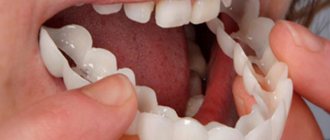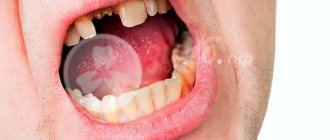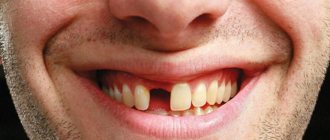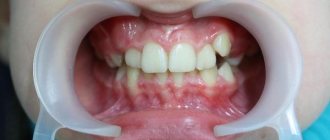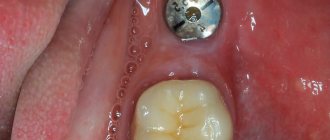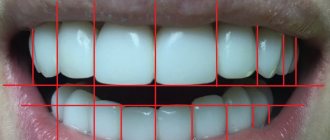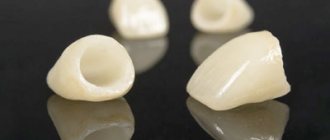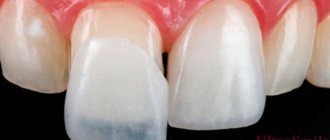What do we mean when we say “I want beautiful teeth”? In the world of ordinary things, “beautiful” most often means “noticeable, eye-catching.”
When we buy beautiful things, we expect that we will be able to attract the gaze of others, but with beautifully made teeth it is different. Beautiful teeth make the face attractive, if they are not obvious. Only you and the dentist know the secret to a renewed smile.
How to achieve such “inconspicuous beauty”?
Making a tooth both beautiful and inconspicuous means skillfully choosing the shape, surface relief and color. In this case, the restoration made will organically fit into the dentition, making the renewed smile beautiful and harmonious.
The main reason why a new tooth or restored part differs from natural teeth is a difference in color.
The fact is that we see objects and determine their color by the spectrum of light that they reflect. The path that light travels depends on the shape of the surface and the internal structure of the tooth.
The surface of a natural tooth has a complex macro- and micro-relief, and the internal structure is not uniform. Manufacturers of dental materials take into account the structural features of natural teeth and offer dentists and dental technicians materials that imitate the properties of enamel and dentin, of varying transparency and shades.
The layer-by-layer application of such materials allows you to create restorations that are as similar in structure to natural teeth and indistinguishable from them in color.
Is it so easy to put an invisible filling on a front tooth?
If the tooth is not very badly damaged, you will be offered to restore it with a filling. Aesthetic restorations made in one visit to a dentist are called “direct”.
The procedure for restoring a chipped part of a tooth seems simple, but it is not: the tooth is unevenly colored - it is darker at the gums, and almost transparent at the cutting edge. It will surprise you to know that teeth contain colors ranging from pink to blue, but the main shades are yellow, brown and gray.
Only with practice does a dentist develop an intuitive understanding of the sequence and which shades to use when layer-by-layer restoration of a particular tooth.
If you are interested, watch a video about how aesthetic restoration of the front teeth is done using Enamel plus material.
Dental restoration options
The clinic can provide all types of dental restoration services.:
- Artistic restoration using advanced filling materials.
- Restoration of a pulpless (dead) tooth, if the root canals are treated correctly. Pins and crowns are used.
- Microprosthetics: veneers, onlays, inlays.
- Restoration of the coronal part after implantation: fixation of the crown to the implant.
Features of aesthetic restoration of pulpless teeth
Some patients experience darker teeth after nerve removal.
To prevent a “dead” tooth from standing out among the “living” ones, the doctor can veneer the visible part with filling material. To do this, the top layer of enamel is removed and replaced with a lighter composite material. This is a fast and relatively inexpensive method of aesthetic restoration.
Despite the fact that modern filling materials make it possible to restore a tooth “without anyone noticing,” over time, by absorbing the dyes contained in food, composite restorations become visible and have to be replaced.
Prosthetic options if a tooth is broken (the root is preserved)
- extension on a pin,
- stump tab,
- crown,
- removable denture.
Next, we will consider in more detail all the proposed solutions.
Extension on a pin
How to hide the absence of a front tooth (and chewing tooth) if it is broken? Here, extensions on a pin are often used. To do this, the root canals are depulped, filled, then thin pins are placed in them - usually metal, but fiberglass and carbon are also common. The top of the pin remains outside and becomes the basis for building up a composite filling. Moreover, a filling can restore both the entire broken crown and become a support for an artificial one (we’ll tell you more about crowns below).
The advantages of extensions on a pin are that the entire restoration can be completed in just 1 visit to the clinic. And it's relatively inexpensive. But there are more disadvantages here. For example, pins often break (even if there is a crown on top), and it is very difficult to remove them; you even have to remove the root. Another disadvantage of extensions is that the filling composition has a short service life. Only 3-4 years will pass, and the filling will darken from food coloring and sag. And it will chip from high pressure even earlier - especially if you make an extension on the pin in the side zone, where the loads are the highest.
Stump tab
How to hide that a front or side tooth has broken at the root? Extensive destruction of the coronal part makes the installation of pins and filling impractical - such a restoration will simply fall out or break in a short time. Therefore, a more reliable solution is needed here. So, if a tooth is broken almost flush with the gum, but the root itself is healthy, then dentists recommend installing a stump tab - it both strengthens the root and becomes an analogue of the tooth stump (the tip that has broken off).
The stump inlay very well withstands and distributes increased chewing loads, i.e. prolongs the life of the tooth root. An artificial crown or bridge is placed on top of the tab, and sometimes a filling is simply added, depending on the situation. There are practically no disadvantages to inlays, but you need to understand that if there are cracks on the root or the chip has gone very deep under the gum, then such a root will not support the inlay and the prosthesis on top.
Crown – which one is better?
An artificial crown is placed on the remaining tooth stump, pin or stump inlay. It can be made from ceramics, metal-ceramics, ceramic composites, zirconium and aluminum dioxides, plastics and metal-plastics. When replacing prosthetics of the frontal (front) and chewing zone, it is necessary to take into account that when replacing incisors and canines, aesthetics play an important role, and when replacing premolars and molars, functionality and reliability play a major role.
To restore front teeth with crowns, the following materials are most often used:
- ceramics: better than other materials in terms of imitation of natural enamel - it is almost impossible to distinguish them by eye (for example, E.max from Ivoclar Vivadent). But it is not suitable for fixation on a metal stump tab, because... fragile ceramics will break,
- metal ceramics (but only a crown with shoulder mass): because At the bottom of a conventional crown without a shoulder mass, a thin strip of metal remains, which, when in contact with the gum, causes a visual “blueness” effect. Among dentists, the brands EX-3 from Kuraray Noritake, Duceram plus from Dentsply Sirona,
- zirconium dioxide with ceramic veneer: since “pure” dioxide has an unnaturally white color, it is recommended to cover it with a layer of aesthetic ceramics with a shade of enamel (exactly the same as the patient’s). The Prettau Anterior brand has proven itself well.
REPROSTHETICS WITH ACRYLIC PROSTHETICS - RUB 150,000. instead of 180,000 rub. until January 15, 2022!
Re-prosthetics with an acrylic bridge on a metal frame (all included) up to 12 units.
Call now or request a call
To restore chewing teeth with crowns, it is recommended to use more durable materials than ceramics. For example, it could be classic metal ceramics - even if the gums around it begin to “darken”, it will not be noticeable in the lateral zone. But the best choice is zirconium dioxide, which can withstand maximum loads for a long time (the service life of such a prosthesis will be at least 20 years).
Removable denture
A removable denture that an orthopedic dentist can install if the crowns of 1-2 teeth have broken off is an immediate denture or “butterfly”. It is a small orthopedic structure consisting of a plastic crown and a section of artificial gum. Along the edges of the denture there are 4 pink clasps (hooks), which, when installed, clasp the adjacent teeth.
What to do if there are several fillings on a tooth and you are tired of changing them
If you are tired of changing fillings, but want your tooth to always look “like new,” the best solution would be to install:
- ceramic veneer if the tooth is “alive”
- a ceramic crown if the tooth is pulpless
Aesthetic restoration of teeth with veneers and crowns are classified as “indirect” restorations, since they must be prepared in a dental laboratory before installation. Unlike “direct” restorations made from filling material, ceramic crowns and veneers will not change their color over time and will always look “like new.”
The ceramics from which crowns and veneers are made are close in optical properties to the enamel of natural teeth, so talented dental technicians manage to create teeth that are indistinguishable from natural ones. But in such dental restoration a new level of complexity appears: how to make sure that a dental technician who does not see the patient understands what color a veneer or crown needs to be made?
Artistic restoration of teeth
One of the most common methods is to resort to artistic dental restoration. This technique is fast and effective. A patient comes to the doctor with a problem and leaves with a “new” tooth. The procedure is carried out directly in the human oral cavity. During extensions, various composite compositions are used. The main advantage is naturalness and naturalness, the effect is simply amazing. It is difficult to recognize that the edge of the tooth is made of artificial material. In order for a tooth to last a long time, you need to follow a number of rules and protect the tooth from hard foods.
Teeth colors
This is where the color scale comes to the rescue, in which the teeth are divided into groups depending on the shades and their intensity.
It would seem that it would be difficult, given a scale, to find the desired color match. However, the choice is not as obvious as it might seem. Any surrounding colors, especially bright ones, from the patient’s makeup to the color of furniture and walls, disrupt the perception of shades.
The perception of colors is purely individual, and also deteriorates with age, so often when choosing a color, the doctor asks the opinion of the assistant and his colleagues. Lighting plays an important role in determining color (it can be artificial, natural or mixed).
Since the veneer and crown are placed on a ground tooth, it is necessary to predict what color this combination will produce.
Why a new tooth may be noticeable
It happens that when choosing a color among the reference teeth, you can find a surprisingly suitable one. The laboratory makes the restoration in accordance with the specified color, but it looks like a “stain” in the dentition. Most often this happens if the tooth is restored with a metal-ceramic crown, and the neighboring teeth are “alive”.
Above we talked only about ceramic veneers and crowns, but it happens that in order to reduce the cost of prosthetics, the patient chooses metal-ceramic crowns, the aesthetic properties of which differ from all-ceramic ones not for the better.
The metal from which the crown frame is made does not allow light to pass through at all, and the dental technician, by combining paints and shades, tries to create a feeling of depth and transparency.
The task of “matching the color” is simplified if you choose ceramics (lithium disilicate) or zirconium dioxide lined with ceramics for the production of restorations. These materials transmit light well, but there are difficulties with color selection in this case:
- reference teeth colors in the clinic and laboratory may not match
- During the manufacturing process, after firing, ceramics may change color slightly
- ceramic masses may vary in color depending on the batch
- Even an experienced dental technician is not always able to select the combination of ceramic masses necessary to obtain the desired color
technique of layer-by-layer application of Noritake ceramic mass
It is precisely the difficulties of production that explain why, after trying on crowns and veneers, they often have to be returned to the dental laboratory for revision.
Tooth fracture: definition, causes
A tooth root fracture is a significant violation of the integrity of layers of hard dental tissues, including enamel, dentin, and pulp. Such damage is typical mainly for the upper frontal incisors.
Broken tooth at the root
The most common cause of fractures is trauma. At risk are athletes (boxers, wrestlers, hockey players, extreme sports athletes, etc.), stuntmen and representatives of other dangerous professions, and children. Individual cases of fracture due to the unprofessionalism of doctors cannot be excluded, for example, when the size of the holes in the pins is incorrectly selected. Sometimes during the process of tooth extraction, the dentist may miscalculate the effort and accidentally damage the adjacent tooth with a metal instrument.
Athletes are at risk
In people with weakened enamel or advanced caries, a tooth may break off while eating solid foods. Finally, the cause may be a congenital abnormality of the jaw structure, in which the load on the dentition is distributed unevenly.


